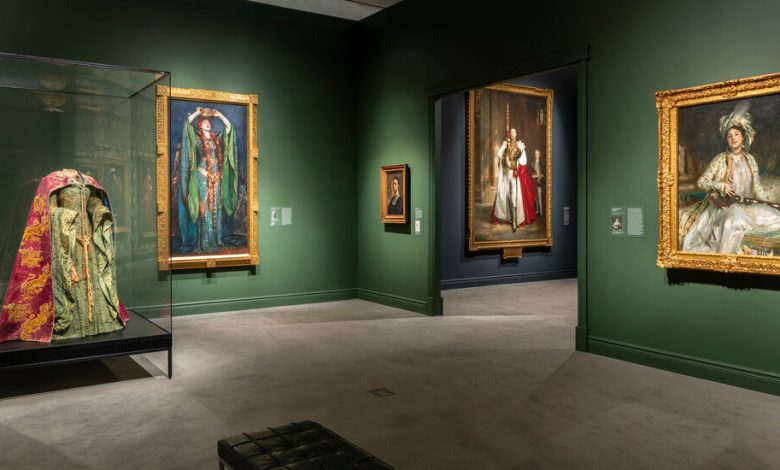Sumptuous Attire Shines in John Singer Sargent’s Portraits from the Gilded Age

The painter John Singer Sargent has sometimes been dismissed as an artist of flattery and frivolity — a portraitist-for-hire who catered to the vanities of his elite subjects, whether they were British aristocrats or Boston Brahmins. Often, these criticisms have centered on fashion: The writer D.H. Lawrence once ridiculed Sargent’s works as “nothing but yards and yards of satin from the most expensive shops, with some pretty head propped up on the top.”
The exhibition “Fashioned by Sargent,” at the Museum of Fine Arts, Boston, which travels to Tate Britain early next year, skillfully parries these jabs with some 50 canvases in which style and substance are deeply intertwined. This is a show to win over even the most hard-boiled Sargent skeptics, turning a purported weakness — the artist’s obsessive attention to his subjects’ attire, expressed through both of-the-moment outfit choices and fabric-flaunting brushwork — into a strength.
And yes, there are clothes — magnificent examples of couture and costuming, including some of the exact pieces worn in the paintings. Anyone partial to Julian Fellowes dramas will find, in time for the second season of “The Gilded Age,” ballroom-hushing silk and velvet dresses by the House of Worth and requisite accessories from Chantilly lace fans to the feathery swoosh of a hat ornament known as an aigrette.
But fashion, in this show, is most interesting as an expression of Sargent’s sensitivity to difference — his flouting of aristocratic conventions, gender norms, and much else. His subjects (many of whom he counted as friends) included women involved in the nascent suffragist movement, men who favored flamboyant or dandyish attire, and Jewish families who were subjected to antisemitic insults as they attempted to navigate British society. And when Sargent prepared them for their portraits, choosing their outfits and adapting power poses from Van Dyck or Velázquez, he acknowledged and often played up this outsider status.
He was an outsider himself — an American who had been born in Florence, Italy, to expatriate parents and educated in Paris, later moving between London and Boston. He is also thought to have been gay; although he was extremely private about his romantic life and the scholarship on his sexual identity is not definitive, a recent exhibition of Sargent’s drawings at the Isabella Stewart Gardner Museum found compelling suggestions of homoerotic desire.
In the exhibition’s most striking works, fashion accentuates an overall sense of vitality and self-possession (one that could be radical in a social climate that valued demure women and businesslike men). In 1901 Sargent painted the sisters Ena and Betty Wertheimer, daughters of a German Jewish art dealer and good friend of the artist, standing arm in arm and with broad, confident smiles as they show off stunning, low-necked evening gowns of crimson velvet and white satin. Ena rests her hand on a large Chinese vase, in a nod to the family business (as well as to her own role as a gallerist).
Later, in an even more exuberant work from 1904 that was commissioned on the occasion of Ena’s wedding, he depicted her acting out the traditionally male role of a cavalier — grinning beneath a plumed hat as she tosses a cloak across her shoulders and brandishes a broomstick in place of a sword. The painting is titled “Ena Wertheimer: A Vele Gonfie” — the subtitle translates from the Italian as “in full sail” — and neither painter nor subject is holding anything back. In the exhibition catalog, the work is described as a “sexualized cross-gendered, mock-aristocratic performance” — certainly not a typical wedding portrait.
In another portrait that plays with gender, and one that was made at the artist’s behest rather than commissioned, Sargent posed the illustrator and designer W. Graham Robertson (a member of Oscar Wilde’s circle) as what one critic called “the ideal dandy” — wrapping his slight figure in a long Chesterfield coat, accessorized with a jade-handled walking stick and a fluffy poodle.
The exhibition, organized by the MFA’s senior curator of American paintings, Erica E. Hirshler, uses anecdotes from the making of Robertson’s portrait and many others to establish that Sargent flexed his muscle when it came to choosing his sitters’ garb and in the styling of an outfit: When Robertson balked at posing in his overcoat in the summer heat, for instance, Sargent insisted: “But the coat is the picture — you must wear it!” His idea for the controversial dropped shoulder strap of the little black dress worn by “Madame X” was eventually readjusted to its current, upright position after a disastrous outing at the Paris Salon of 1884.
If his portraiture approached theater, Sargent also had a way of turning moments from the stage into images richly steeped in the history of painting. His painting of the actress Ellen Terry in the role of Lady Macbeth, which she played to great acclaim at London’s Lyceum Theatre in 1888, recasts her as a Pre-Raphaelite heroine with long red plaits and a shimmering blue and green gown known as the “Beetle Wing Dress” (which boasts elaborate draped sleeves and actual beetle wing cases affixed to its surface). The costume, made by the designer Alice Comyns-Carr in collaboration with Terry and the dressmaker Ada Nettleship, is exhibited alongside the painting and may be the show’s most spectacular garment.
Sargent’s penchant for theatricality lends a delicious irreverence to his portraits of status-obsessed British aristocrats, in particular. His massive painting of Charles Stewart, the sixth Marquess of Londonderry — shown in full regalia and wielding the Great Sword of State at the coronation of Edward VII — lavishes so much attention on the ceremonial garb as to give the impression of royal cosplay.
Sargent often used fabric as an active element of the picture, draping and pinning it to supplement his subjects’ outfits. (He once referred to himself, in jest, as a “painter and dressmaker.”) You can tell when he is improvising with cloth or paint or both; in his double portrait of the mother and daughter Gretchen and Rachel Warren, for instance, where the daughter’s “sleeve” dissolves into an amorphous agglomeration of white and pink brushstrokes.
Fabrics, particularly those with a reflective sheen, also allowed Sargent to deploy the sort of rapid, wet-on-wet brushwork used by one of his idols, the 17th-century Dutch painter Frans Hals. As he once advised a student, “Begin with Frans Hals, copy and study Frans Hals. After that go to Madrid and copy Velázquez … leave Velázquez till you have got all you can out of Frans Hals.”
It’s the Impressionists, however, who haunt the revelatory works in the show’s final gallery. Inspired by the group’s interest in optics and color mixing, and in close correspondence with Monet, Sargent made a series of paintings exploring the prismatic effects of sunlight on white clothing. Women in airy white dresses, holding white parasols as they stroll along riverbanks, diffuse and refract their surroundings. A scene of Sargent’s sister Violet fishing experiments with different textures of white-on-white, from sheer dotted cloth to clouds reflected in the water.
D.H. Lawrence, in his takedown of Sargent’s “yards of satin,” even noted a kind of Impressionism: “The optical vision, this sort of flashy coloured photography of the eye, is rampant.” To Lawrence, that was another flaw; to us, it looks more like an early glimmer of modernism.
The catalog for “Fashioned by Sargent” has much more to say about Sargent’s critics, as well as champions of the artist such as Henry James and Edith Wharton. As it makes clear, art and fashion in Sargent’s time were intimately linked through Salons and Royal Academy exhibitions — performative social events where both the portraits and their subjects were closely scrutinized. This important context may not be apparent from the MFA show alone.
What will be obvious to any viewer, though — especially at a moment in which other museums and galleries are filled with portraiture, by artists from Alice Neel to Henry Taylor — is that Sargent, while swathing his striving subjects in luxurious-looking layers of satin, velvet, and organza, never failed to reveal their essential humanity.
Fashioned by Sargent
Through Jan. 15, at the Museum of Fine Arts, Boston, 465 Huntington Avenue, Boston; (617) 267-9300, mfa.org.



